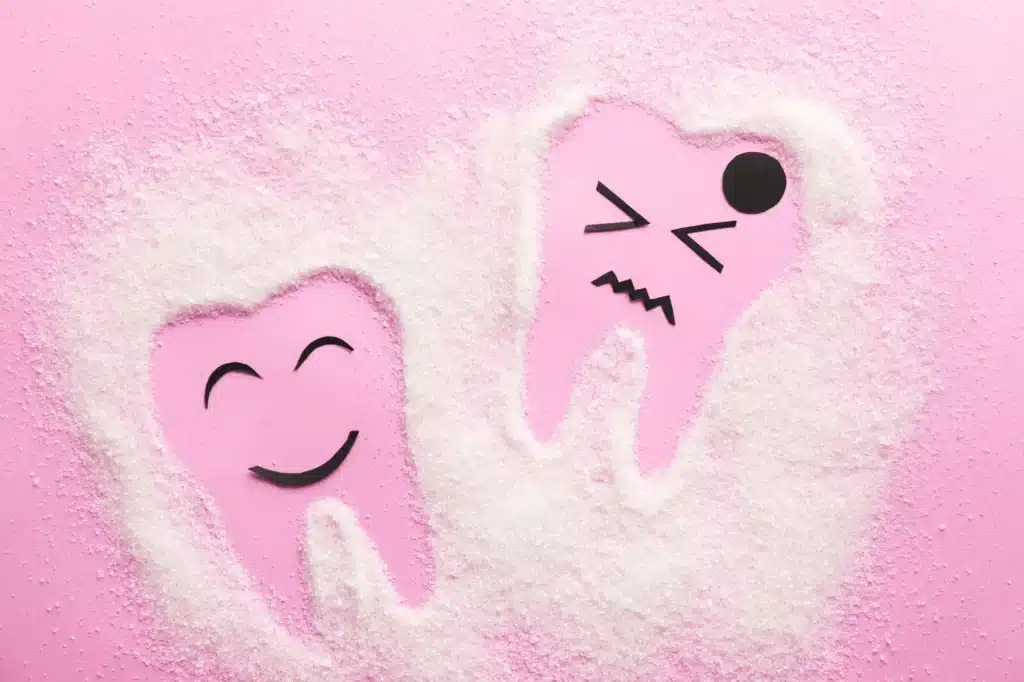Tooth cavities can lead to severe oral infections if left untreated. Learn how to tell if you have a cavity to avoid future complications.
Tooth Cavity
When bits of food and bacteria stick to your teeth, they can form a “plaque.” The bacteria in plaque produce acids that can wear away the protective layer on your teeth called “enamel.”
To prevent this, brushing and flossing your teeth regularly is essential. This helps remove the sticky plaque. If you don’t remove the plaque, it can damage your teeth and create holes, which we call “cavities.”
A cavity is like a tiny hole in your tooth. The cavity can slowly destroy your tooth if you don’t treat it. And if you leave it for too long, it might lead to more severe problems, like a tooth abscess or an infection that can spread to your whole body, which can be very dangerous.
Some areas in your mouth where plaque is more likely to form include:
- The chewing surfaces of your back teeth (molars) where tiny bits of food can get stuck in the grooves and crevices.
- Between your teeth.
- The bottom part of your teeth near your gums.
How to Identify Tooth Cavities?
People often wonder how to tell if you have a cavity. Let’s explore proven ways and learn how to tell if you have a cavity.
Tooth Pain
If you wonder how to tell if you have a cavity, first look for signs of tooth pain. Usually, when you have a cavity that’s not treated, you’ll start to feel pain.
If you get a toothache, it’s time to visit the dentist. Don’t delay. In the early stages of cavities, you might only feel pain when you bite down on something, like a piece of candy.
As it progresses, you’ll feel tooth pain even when chewing on something soft and in severe cases, you’ll have constant tooth pain.

Tooth Sensitivity
A less obvious sign of how to tell if you have a cavity is tooth sensitivity. Sensitive teeth can be like having a cavity. It feels like an itch or tickle in your teeth at times.
Sensitivity happens because bacteria are wearing down your tooth enamel, which usually protects the nerves in your teeth. As the bacteria eat through the enamel, your nerves make your teeth feel sensitive.
In the early stages, your tooth might feel sensitive when you eat something hot, cold, acidic, or sugary, but not always. If using a sensitive toothpaste doesn’t help, you likely have a cavity and should see your dentist.

Holes in Your Teeth
One of the apparent signs of how to tell if you have a cavity is tooth holes. When you can see a hole in your teeth, your cavity has progressed quite a bit. You’ll need multiple fillings or a root canal if there’s an infection in your tooth and it becomes an abscess.
If you notice a hole on top of your tooth, run your tongue over it. If you feel a hole, it’s likely a cavity. It’s easier to spot holes in your bottom teeth in the mirror. You can use a dental mirror to check your top teeth.
If you see any holes, don’t wait. Visit a dentist to remove the bacteria, fill your tooth, or put a crown on it.
Dark Spots on Your Tooth
When a cavity goes untreated for a long time, it becomes noticeable. It appears as a dark spot on the affected tooth. You might have a cavity if your tooth changes color and looks discolored.
This dark spot shows up before actual holes form in your tooth. There could be a hidden hole underneath it. So, instead of holes, you’ll often see a dark spot, usually gray, brown, or black. When you spot this dark area, bacteria have started damaging your enamel. If you see a dark spot, it’s a clear sign that you may have a cavity.
Halitosis (Bad Breath)
Halitosis is a sign of how to tell if you have a cavity. As the cavity progresses and bacteria invade the tooth, it can lead to bad breath, also known as halitosis. The same bacteria causing the cavity is responsible for the bad breath.
You may develop bad breath when enough bacteria enter your mouth to create a cavity. You might notice it when you brush your teeth or tongue, and you could also have bad taste in your mouth.
If you experience halitosis, visiting a dentist is a good idea. You might have an advanced cavity. The earlier you address it, the easier and less costly it will be to treat.

Pus
Pus is a sign of a severe problem caused by a cavity that has become an abscess. An abscess can lead to intense pain, fever, and swollen glands. If you wonder how to tell if you have a cavity, then pus can’t be ignored. It’s a sign of tooth cavities.
Your dentist can help by prescribing an antibiotic to stop the pus and prevent the abscess from worsening. An antibiotic can eliminate the bacteria that has spread through your tooth and keep it from spreading to other areas of your mouth.
Chips or Broken Tooth
Among the signs of how to tell if you have a cavity is a broken tooth. If you have a chip in your tooth or your tooth has a more significant break, it could indicate the presence of a cavity. This can happen when you bite down on something hard or eat a chewy item like candy.
When your tooth is chipped or broken, it’s crucial to treat the underlying cavity before it damages the rest of the tooth. In the worst-case scenario, when bacteria causes a tooth to break extensively, it may not be possible to save the tooth. In such cases, you might need to have the tooth removed.
Conclusion
The blog guides you on how to tell if you have a cavity. Carefully look for the signs of cavities and consult your dentist. Don’t ignore the signs of cavities, which can lead to severe complications. Visit your dentist regularly to diagnose any problem before it can cause oral concerns.


